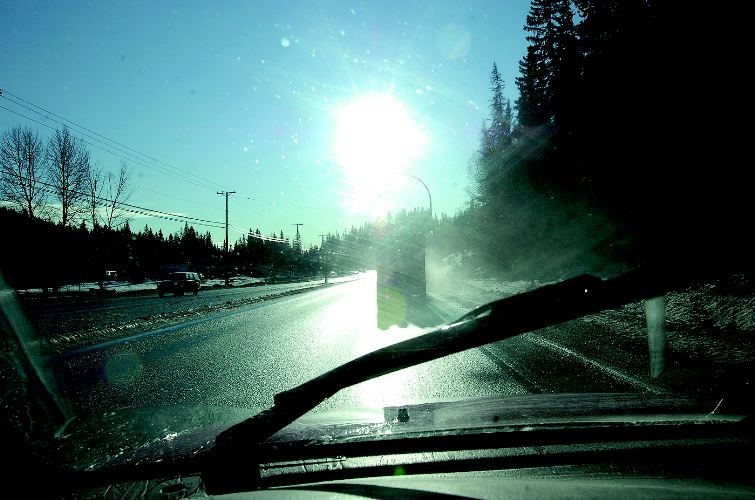Warm-cold, warm-cold. For days this trend has turned roadways into skating rinks and imperiled motorists who don't drive accordingly. Crashes on streets, highways, even railway crossings in the region have had the icy conditions as a factor.
The case closest to home was on Wednesday morning when a loaded logging truck near Summit Lake apparently could not stop at a slippery intersection and slid off a logging road into the path of another loaded logging truck travelling down Highway 97.
"We followed the plow truck for awhile and we could see the sparks coming off the blade, and we thought it was a total waste of time, the road seemed bare so why was he doing that, but there was a little layer of frost all the way along and we didn't even realize that until we tried to stop for the logging trucks," said one driver who came upon the collision. "It was really slippery. We had a hard time getting ourselves stopped."
Mick Jones, transportation manager for the City of Prince George, said this kind of weather is not strange or unusual for safety and maintenance crews except for the time of year. This prolonged period of warmth is not typical for late December-early January but the tactics are the same to keep the roadways passable.
It is a steady dose of salt and sand, or more correctly, salt and fracture. The rocky debris spread by city trucks is not sand at all, which has rounded features if you look at each grain under a magnifying glass. Fracture is pulverized rock so its aspects are angular.
"The fracture digs in and gives more traction. It also doesn't roll like sand does when you try to brake on top of it," Jones said.
"All our winter fracture has a salt component to it, usually a two per cent mixture [to keep it from freezing into lumps] but in certain conditions we use straight salt. Right now it is mostly the fracture mixture."
The salt becomes more practical in times of light snow. A chemical reaction happens between the salt and frozen water that causes a melting effect. When the weather is well below zero, this effect doesn't work as well but when the temperatures are near the freezing mark it is quite effective, said Jones. Salt is applied most often to intersections, corners, places where traction is more important for public safety.
Because there has been little new snow, salt hasn't been as critical to distribute as the fracture mix, Jones added, and the extra bonus is, plows have not been out pushing the traction materials off the street. The fracture that was spread around last week is still there on the roads today.
HOLES IN WINTER
Pothole crews have been pressed back into service as a result of the warm snap the city is experiencing.
The warm days and freezing nights are daily assaults on the asphalt, said Jones.
"Any pothole patching done now is with cold mix which is an inferior product to a hot mix patch, but for that you need warmer and drier conditions," he explained. "It is harder to get the good bonds we need for the long-term solution, we know we are not going to get a long life span out of the patches on these potholes we are doing midwinter."
In general, what causes the pothole is daytime water trickling into cracks and rents in the pavement, then when it freezes at night that water expands and breaks the cracks into bigger holes.
Jones said crews work first on the potholes that pose a risk of doing vehicle damage, then they move on to nuisance holes.
Anyone who knows of an unfixed pothole can report it by calling City Hall (250-561-7600) or go to the City of Prince George website (www.princegeorge.ca) and click on the "Report a Pothole" link in the left column of the home page.



